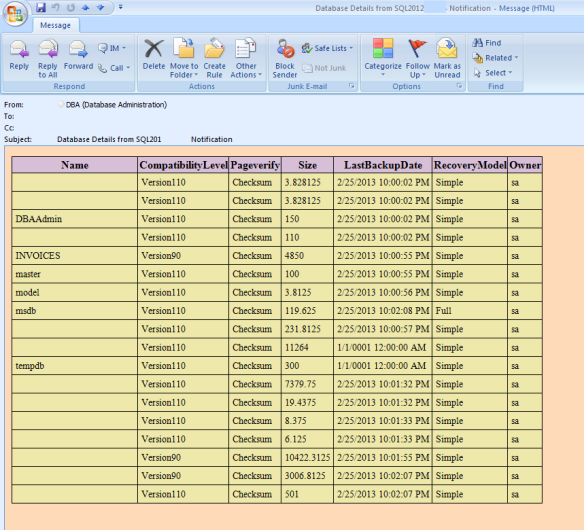Would you love to get a weekly status report of all the databases hosted on your mission critical servers? ,Would you love to get a report which will help you maintain and manage your large shared SQLServer environments neat and clean?
If your answer is Yes, then powershell is your solution. Welcome to the world of powerful powershell(Well, that sounds like a good marketing buzz word !).
Lets’ think about a large enterprise situation where in you are managing a huge SQLServer shared server which has many databases. Each day your DBA team members will be adding new databases to the server, and you would like to get a status report to ensure that the databases are compliant to the regular database ‘rules’ as you are responsible for the well being of the environment.
Example – No database can have a compatibility level which is less than 110,No databases can have owner other than SA etc.
I’m a great fan of the articles written by Microsoft Scripting Guy, Ed Wilson(B) and one of his articles gave me a quick idea of deploying a powershell function which will pull the database details on a weekly basis.
I slightly modified his code mentioned in the article here (This is a very useful/detailed article, and I highly recommend this to everyone ) and my little function will pull database information such as Name,PageVerify,CompatibilityLevel,Size,LastBackupDate,Recoverymodel,Owner etc and will send across an email.
Note – All credits goes to Ed for his original code. I have great respect for Ed,and if you are interested in powershell, then I highly recommend reading his articles.
Here is the powershell function -
#Remember to make changes for SMTP area
Function Get-DBInfo ($SQLInstance)
{
if ($SQLInstance.Contains(“`\”))
{ $location = “SQLSERVER:\SQL\$SQLInstance\Databases” }
else
{ $location = “SQLSERVER:\SQL\$SQLInstance\DEFAULT\Databases” }
$style = ‘<style>’
$style = $style + ‘BODY{background-color:peachpuff;}’
$style = $style + ‘TABLE{border-width: 1px;border-style: solid;border-color: black;border-collapse: collapse;}’
$style = $style + ‘TH{border-width: 1px;padding: 2px;border-style: solid;border-color: black;background-color:thistle;font-size:16}’
$style = $style+ ‘TD{border-width: 1px;padding: 5px;border-style: solid;border-color: black;background-color:palegoldenrod;font-size:14}’
$style = $style + ‘</style>’
$body=dir -force $location | where-object {$_.Name; $_.Refresh()} |
Select Name, CompatibilityLevel,Pageverify,Size,LastBackupDate,RecoveryModel,Owner |ConvertTo-Html -Head $style -Property Name,CompatibilityLevel,Pageverify,Size,LastBackupDate,RecoveryModel,Owner |Out-String
#Set your smtpserver information
Send-MailMessage -To “anupsiva.das@abc.com” -Subject “Database Details from SQL2012 – Notification” –From “dba@abc.com” -SmtpServer “mailserver.abc.com” -Body $Body -BodyAsHtml
}
Get-DBInfo SQL2012
<Modified 01/27/2013> Above code was modified to pass the correct variable <Modified>
If you schedule this function as a SQL Job then you will receive automated emails according to your requirements.
Here is a sample email which was generated by the Get-DBInfo function.
Conclusion
Automated reports is going to help DBAs a lot and powershell is making life more easier by helping us to create highly flexible functions.
Thanks for reading and keep watching this space for more.




